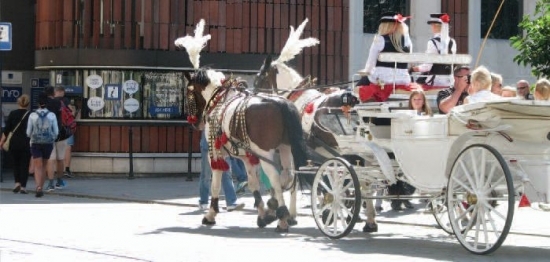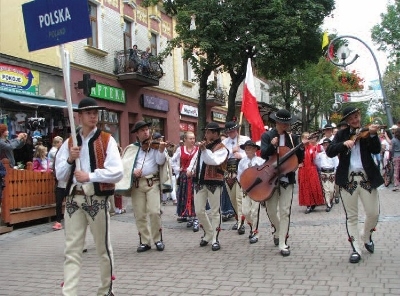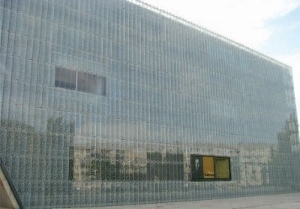A Polish Surprise
I was reluctant to go to Poland, but Ruti wanted the grandchildren to see the place where her parents had come from – a small town (Pruszkow) near Warsaw; so last August, two grandparents and their three oldest grandchildren went off to see for themselves.
For me it was a holiday of surprises.
We spent most of our time in Warsaw, Cracow and Zakopane (a resort town in mountainous countryside), taking one afternoon off for a quick look at Pruszkow.
The city centers were vibrant and clean, with wide cobblestone streets flanked by tall trees, and low, attractive, centuries-old buildings. Many buildings had sloping red roofs under which jut tiny additional "roofs" or dormers, covering the windows of the attic rooms on the top floors.
Another surprise was the politeness and helpfulness of the people. Whenever we came to a new place, toting our baggage and looking around for a tram or the right street, someone would offer to help, even before we asked. And, after half a century of living in Israel, I was impressed with the traffic – never a hoot heard. Whether cars or horse-drawn tourist "chariots", the message was "pedestrians first".
Our first stopover was Cracow, where we stayed in the tremendous central square of the Jewish quarter, the historic town of Kazimierz. Helena Rubinstein grew up in this three-storey building, and her picture and story are displayed along the corridors.
The central part of the Jewish quarter is one great showcase, with quiet crowds and open-air tourist taxis streaming in throughout the day. The square is packed with restaurants; bands play in the street, and all the old signs are here. One sees the Magen Davids on the iron-work fences; photographs and lists of names of the Jews who once lived here; Jewish names on signs over former (now non-existent) shops. The restaurants advertise "Jewish" and "Israeli" food, Hebrew writing is seen in some places, and on Friday night candles are lit in a large menorah. The synagogues are open to tourists, and seem to be in use for services mainly on Friday evenings.
An unexpected attraction was the Jewish klezmer music, performed by several bands in the square every day, until 11pm. They take turns in performing for the seven or so restaurants on our side of the square. Below our windows stretched a sea of large white umbrellas over the outdoor tables. The musical arrangements were truly wonderful.
Jewish signs, stories, pictures, and names were everywhere: everything was there – except the Jews. A memorial to departed Jews, or a tourist gold mine? I would say both.
After World War II, the Jewish quarter in Cracow was run down and neglected. The spark that started its renovation came in 1993 with the movie, Schindler's List. People began to come to the quarter to see for themselves. As business increased, so did the renovation of the quarter begin. Today it is a delightful place to visit.
I loved the Jewish quarter. However, our grandchildren gave their first preference to the old town of Cracow, about 30 minutes' walk away, a larger and even livelier place. So at the earliest opportunity the grandparents went to see for ourselves – as usual walking.
People crowded the wide and cobbled streets connecting several large squares. Outdoor musicians serenaded the passers-by. We saw the usual shops, stalls, open-air cafés and restaurants in the squares, an arcade, and a church advertising recitals of organ music. Everything we bought (food, clothing, equipment etc.) was less than half the price we pay in Israel.
Weaving through the crowd and clopping over the cobblestone streets were horse-drawn carriages with sight-seeing tourists. The carriages s were painted gold and white, the drivers wore elegant and colorful riding apparel and the magnificent horses were fitted with colored and patterned cloth livery running along the length of their bodies. The horses trotted along proudly, tossing their heads and waving their tremendous white plumes.
Our next visit was to Zakopane, a lively resort town 800 meters above sea level. Behind the town were green mountain ranges and, behind them, the Tatra mountain range, with the highest mountain peak in Poland. Zakopane is known as the winter capital of Poland, but as I like warm weather, I was quite happy that we were there "off season".
In the evening, we walked through the town to the main entertainment street. Krupowki Street is a cobblestone street which runs up a gradual slope for about a kilometer. As we walked up we saw a wealth of places to eat, smart stores, pavement artists, musicians and – just our luck! – we had arrived on the first day of the Folklore Festival. Dressed in folk costumes the dancers, singers and musicians from all parts of Poland, other European countries and as far away as Mexico, paraded down the crowded main street, each group with its own band. The crowds streamed and jostled along, the atmosphere was festive, the amount of food served (each serving) was tremendous, and I was horrified at the quantity of leftover food which would probably be thrown away. And I thought Tel Aviv diners were wasteful!
The next day was our mountains day. The first mountain we visited was not particularly high, but we decided to go up by cable car. Unfortunately, the mountain top, which is a long and wide ridge and runs in a fairly straight line, was overburdened with rows of stalls - things to buy, things to eat, one stall after another, plus entertainment for children. (We saw large plastic bubbles, each with a child inside – it seems kids love being tumbled around). We had to walk to specially-built balconies to see the views below.
Eventually, we found an open space on the ridge, took a short walk down the other side of the mountain and reached a grass meadow, where we relaxed. On this side, away from Zakopane, there are more mountain tops, and a village "folded" into mountain ridges below us.
We descended the mountain on a wide chair-lift (each "chair" accommodated eight people). It was a long, tiring, but interesting walk back home. Eventually we reached the cobblestone tourist street of Zakopane, and then branched off to our lodgings. Along the way, we passed a large open field containing a funfair lit up with a sea of colored lights.
The whole of Poland seemed to be here for the festival – talk about crowds and crush!
Another nice day. Our next mountain was part of the Tatra range, which stretches between Poland and Slovakia. We didn't go up the highest peak (2,499 meters – no thanks!) but this time we actually climbed up a difficult trail. The small, winding path was quite steep; some parts were rocky and difficult. After more than two hours of this – and it was a hot day – we met youngsters on their way down, and asked them "how much longer?" Their answer: "Another two hours or so, and you'll reach the top." But, they warned us, "There is a tremendous wind blowing up there."
Well, the grandparents decided (after all, we are in our 80s) to wait for the grandchildren in a shady spot – pine trees and red-berry bushes grow in profusion all over. The three grandchildren set off, but returned after 20 minutes, and we walked down again.
After several days of exploring Zakopane, we left for Warsaw, via Cracow. It was a bus journey of two and a half hours, through hilly and mountainous countryside. On the mountain slopes were villages with wooden houses. They reminded me of Switzerland, except the "chalets" I saw here were built on a larger scale.
In Cracow, we caught the fast train (cheaper than the bus) to Warsaw.
In Warsaw, in a light rain, we found our holiday flat in a wide, cobblestone side street. The street linked up to two (horizontally opposed) main roads, but we were well away from the traffic. On the corner, 40 meters away from us, was one of the highest cathedrals I have ever seen. I felt reassured that with those spires, which we could spot from far away, we couldn't get lost.
Our small balcony overlooked the street, the pavement and the trees. Not far off was the cathedral. The immense Vistula River was a half hour walk away and the Old Town was on a hill across the river. The old town was not as colorful as Cracow, but it had its own charm and attractions.
Over the next few days, we walked several times across the great bridge over the Vistula River, and crossed the river by ferry, a free service. This was the first river I had ever seen which has banks composed of white sand, and semi-clad people were sunbathing on the sand. A real seaside scene.
To reach the Old Town, we walked up the vast hill, past low buildings, and eventually went through large squares, one after another, along cobblestone streets. In one section we saw the impressive remains of the wall which once circled the town.
The first great square we came to was a perpetual showcase of outdoor entertainment. In a second square, we sat outside in one of the dozens of restaurants, and noticed a sign on the house across the way – Madame Marie Curie lived here. There is a museum nearby and we went in to have a look.
Early next morning I was sitting on our balcony overlooking the street and cathedral when I saw a lot of smart-looking cars drive up. For the next half hour, cars drove into the quiet street. Some parked in the cathedral grounds, others in special bays between the trees in the street below. Men and women poured out of the cars. Every one wore an ankle-length dress, with only the colors predominantly white and purple, varying.
A few went into the building opposite us (the church offices), the remainder walked into the cathedral grounds.
A new-looking car drove up and parked across the road. Doors opened briskly – four nuns got out of the back, two nuns from the front. One held a small briefcase.
A man in a large black car drove up and parked in a specially-designated area. He got out of the car and I saw he was wearing a black ankle-length dress and carried a large briefcase.
The scene could have been one of businessmen and women going to the office – except for the uniforms.
One day, we visited the Polin Museum, ("Po li'n" – "Here I will dwell"). Opened over two years ago, the unusual building has high, curving glass walls which glitter in the sunlight. Across the square, facing the building, is a large monument to the heroes of the uprising in the Jewish ghetto.
Inside the museum were pictures and impressive models of the nearly 1000 years of the history of the Jews in Poland. Towards the end of our tour we watched interesting black and white film clips of the aerial battles of World War II, but unfortunately it was near closing time, and we had to hurry.
There is a lot to see in the museum, so don't be like us – come early.










Comments